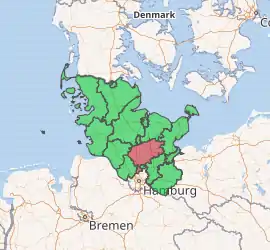Segeberg
Segeberg is a district in Schleswig-Holstein, Germany. It is bounded by (from the southwest and clockwise) the districts of Pinneberg, Steinburg and Rendsburg-Eckernförde, the city of Neumünster, the districts of Plön, Ostholstein and Stormarn, and the city state of Hamburg.
Segeberg | |
|---|---|

| |
| Country | Germany |
| State | Schleswig-Holstein |
| Capital | Bad Segeberg |
| Area | |
| • Total | 1,334 km2 (515 sq mi) |
| Population (31 December 2019)[1] | |
| • Total | 277,175 |
| • Density | 210/km2 (540/sq mi) |
| Time zone | UTC+01:00 (CET) |
| • Summer (DST) | UTC+02:00 (CEST) |
| Vehicle registration | SE |
| Website | kreis-segeberg.de |
History
The history of the district is connected with the history of Holstein. In 1134 the castle of Segeberg was erected as a regional centre from where the reeve of Segeberg ruled. When Schleswig-Holstein became a Prussian province in 1865, the Prussian administration established the district of Segeberg.
Since then the district has considerable grown twice: In 1932 parts of the dissolved district of Bordesholm joined the district; and in 1970 the city of Norderstedt became part of the district.
Geography
The district of Segeberg consists of the agricultural plains between the cities of Neumünster and Hamburg. A southwestern portion of the hilly lakeland called "Holsteinische Schweiz" (Holsatian Switzerland) belongs to the district, as well as some northern suburbs of Hamburg.
Coat of arms
 Coat of arms |
The coat of arms displays :
|
Towns and municipalities
| Independent towns and municipalities |
|---|
| Ämter | ||
|---|---|---|
|
|
|
| 1seat of the Amt | ||
References
- "Statistikamt Nord – Bevölkerung der Gemeinden in Schleswig-Holstein 4. Quartal 2019 (XLS-file)". Statistisches Amt für Hamburg und Schleswig-Holstein (in German).